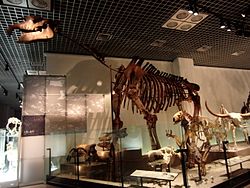Paraceratherium
|
Paraceratherium Temporal range: Oligocene, 34–23 Ma |
|
|---|---|
 |
|
| Skeleton cast of P. transouralicum, National Museum of Nature and Science, Tokyo | |
| Scientific classification | |
| Kingdom: | Animalia |
| Phylum: | Chordata |
| Class: | Mammalia |
| Order: | Perissodactyla |
| Family: | †Hyracodontidae |
| Subfamily: | †Indricotheriinae |
| Genus: |
†Paraceratherium Forster-Cooper, 1911 † denotes extinct |
| Type species | |
|
†Paraceratherium bugtiense Pilgrim, 1908 |
|
| Species | |
|
|
| Synonyms | |
|
Genus synonymy
Species synonymy
|
|
† denotes extinct
Paraceratherium is an extinct genus of hornless rhinoceros, and one of the largest terrestrial mammals that has ever existed. It lived from the early to late Oligocene epoch (34–23 million years ago); its remains have been found across Eurasia between China and the Balkans. It is classified as a member of the hyracodont subfamily Indricotheriinae. "Paraceratherium" means "near the hornless beast", in reference to Aceratherium, a genus that was once thought similar.
The exact size of Paraceratherium is unknown because of the incompleteness of the fossils. Its weight is estimated to have been 15 to 20 tonnes (33,000 to 44,000 lb) at most; the shoulder height was about 4.8 metres (15.7 feet), and the length about 7.4 metres (24.3 feet). The legs were long and pillar-like. The long neck supported a skull that was about 1.3 metres (4.3 ft) long. It had large, tusk-like incisors and a nasal incision that suggests it had a prehensile upper lip or proboscis. The lifestyle of Paraceratherium may have been similar to that of modern large mammals such as the elephants and extant rhinoceroses. Because of its size, it would have had few predators and a slow rate of reproduction. It was a browser, eating mainly leaves, soft plants, and shrubs. It lived in habitats ranging from arid deserts with a few scattered trees to subtropical forests. The reasons for the animal's extinction are unknown, but various factors have been proposed.
The taxonomy of the genus and the species within has a long and complicated history. Other genera of Oligocene indricotheres, such as Baluchitherium, Indricotherium, and Dzungariotherium have been named, but no complete specimens exist, making comparison and classification difficult. Most modern scientists consider these genera to be junior synonyms of Paraceratherium, and that it contains four discernible species; P. bugtiense (the type species), P. transouralicum, P. prohorovi, and P. orgosensis, although the last may be a distinct genus. The most completely-known species is P. transouralicum, so most reconstructions of the genus are based on it. Differences between P. bugtiense and P. transouralicum may be due to sexual dimorphism, which would make them the same species.
...
Wikipedia
